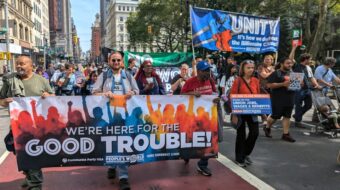Let me begin with the obvious: the left (organized and unorganized) has seldom been of one mind. Differences over aims, strategy, tactics, programmatic demands, forms of struggle, etc. have been commonplace.
This moment is no different. In fact, I would argue that two distinct and competing trends have taken shape in the course of the first year of the Obama presidency.
One trend stakes out a left position on every issue, resists compromise, believes that the Democratic Party has no democratic/reform potential, pays little attention to right-wing extremism in its strategic and tactical thinking, and reduces President Obama to nothing but a puppet of Wall Street.
This trend turns criticism of the Obama administration into a measure of one’s militancy. The sharper the tone the more legitimate one’s left credentials. The main, if not the only, thing holding up far-reaching political and economic reforms, in the eyes of this trend, is the president. Somehow, in this rendition of the political moment, the interaction and struggle between (and within) competing political coalitions/blocs composed of various class and social groupings has no or minimal bearing on the process of change since the 2008 elections. In short, the class struggle in all its complexity is both simplified and invisible.
This same trend “damns with faint praise” the new currents, thinking and initiatives in labor and people’s organizations, while it narrowly defines political independence as only electoral formations outside the two-party system. It acts as if militant minorities and moral outrage can reshape the political landscape alone, forgetting that popular majorities in the end make history.
Finally, this trend places an outsize accent on left initiative and unity, but detached from broader forms of unity and struggle.
The other trend on the left argues that the 2008 elections reset the political terrain to the advantage of working people and their allies.
While the Obama administration is not above criticism, this trend believes that criticism should be constructive and unifying, not a test of one’s radicalism.
The main role of the left, according to this trend, isn’t simply agitational – talking points, sound bites and militant slogans. Political agitation has an important place in class and democratic struggles, but only to the degree that the left is involved in day-to-day struggles in a sustained, practical and non-sectarian way.
In 2008, a broad people’s movement was instrumental in electing Obama and a Democratic majority in Congress. Since then, however, it hasn’t reached the same level and scale of activity. Without reassembling this coalition, progress will be largely unrealized.
This trend embraces left demands, but it embraces broader demands as well that masses of people are ready to fight for. It doesn’t counterpose one against the other. Instead, it sees broader mass demands as a highway that has to be traveled to win more progressive and radical changes.
In a similar vein, compromise isn’t a dirty word in this view. Instead, whether and when one makes compromises depends on a very sober estimate of the balance of class and social forces.
This trend understands as well that its task is not only to unite a broad multi-class coalition in the current phase of struggle, but also to assist the working class and its core allies to impress their unmistakable stamp on the struggle for reforms.
Unlike the other trend that shoehorns Obama into a tightly sealed political shell with little or no political potential, this trend believes he has a role, a potentially major one, to play at this juncture of the class struggle.
By the same token, it strongly rejects the notion that the task of the left is to reconfigure the struggle into a contest of the people’s movement against President Obama.
This trend supports left unity, but insists that practical involvement with broader movements and coalitions and some rough agreement on strategic orientation among left groups are a necessary condition for such unity.
Finally, an independent, labor-based people’s party is a strategic necessity in the view of this trend, but it doesn’t see such a formation on the short horizon. In the meantime, it supports struggles for political independence (which take many forms) both within and outside of the Democratic Party.
No individual, organization or social movement on the left fits neatly into one or the other trend outlined above. Life is always more complicated than broad generalizations. Nevertheless, these two trends are taking more definitive form and the future of the left and its place in U.S. politics, in my opinion, hinges on which trend becomes dominant. I think it is obvious where I stand.










